Deploy to Azure Web Apps
Describes how to set up an Optimizely Content Management System (CMS) site to run on Azure Web Apps.
The example creates an Alloy sample site using Visual Studio, but you can apply most steps to sites created in other ways.
NoteSee also the Installing the Optimizely Alloy sample site video for information about cloud installation.
Cloud requirements
- You need a cloud-enabled license from the Optimizely License Center.
- Microsoft Azure Portal requires an account with login details.
- Content mirroring and workflows are not supported.
- When you install a database using Microsoft Azure SQL Database, ensure that SQL Database supports each product and add-on that you want to use on the site for the site to work properly.
- Ensure that each deployed application and module is designed for the cloud.
Set up a cloud website
The following image illustrates an Optimizely Content Management System (CMS) website running in an Azure Web Apps environment with multiple instances. The website instances share the same SQL database and BLOB storage that stores binary file data in the cloud environment. The sites are load-balanced, and a Service Bus manages events between the CMS websites.
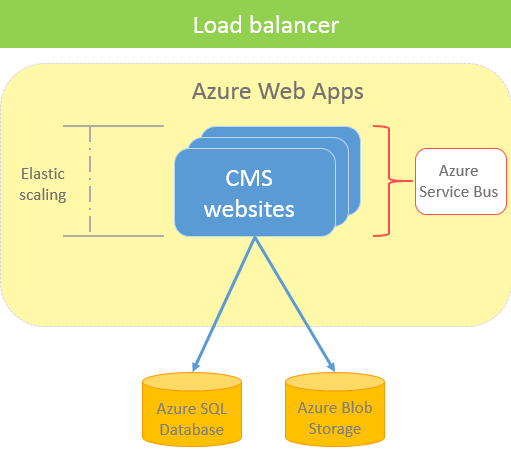
Using App Service plans, you can increase or reduce the number of CMS sites from the Azure portal.
The following steps create a CMS website running in an Azure website environment.
Create a site
- Creating a CMS site is based on the new .NET Core template, see Install Optimizely (ASP.NET Core).
- Install the NuGet package EPiServer.Azure to the project.
- Save your license file under the site root, on the same level in the folder structure as the
/binfolder. The license is used and activated later when you deploy the website to Azure.
Create Azure resources
Log in to the Azure portal to create the necessary Azure components:
-
Create an Azure web app.
a. In the Azure portal, click Create a resource in the top left corner, and select Web App.
b. Choose whether to create a resource group or use an existing group. (A resource group is a logical container into which web apps, databases, and so on are deployed.)
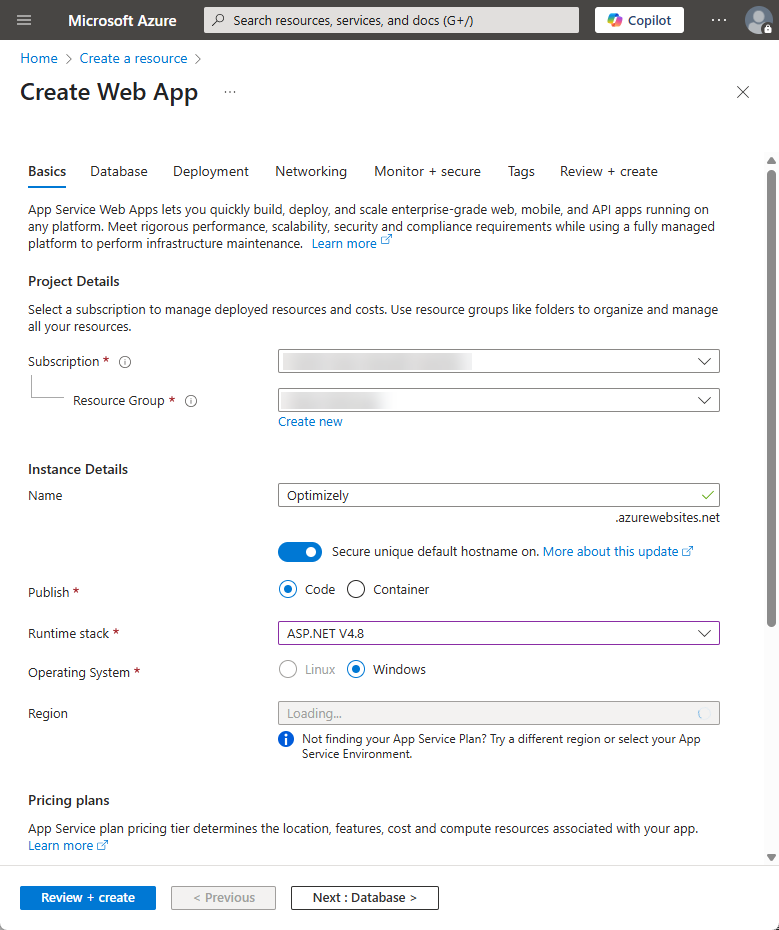
c. Enter a name for your web app. The name must be unique for web apps in Azure.
d. Select Publish: Code, your Operating System, and Region.
e. Select or create an App Service plan.
f. The performance monitoring service Application Insights is enabled by default. If you want to turn it off, go to Monitoring and select No under Enable Application Insights.
g. Click Review + create at the bottom of the panel and then Create again after you have reviewed your settings.
TipSelect Pin to dashboard to make it easier to find your web app later.
-
Create a SQL database.
a. Select Create a resource in the top left corner, and select SQL Database.
b. Select an existing server or create one, and provide a login user and password.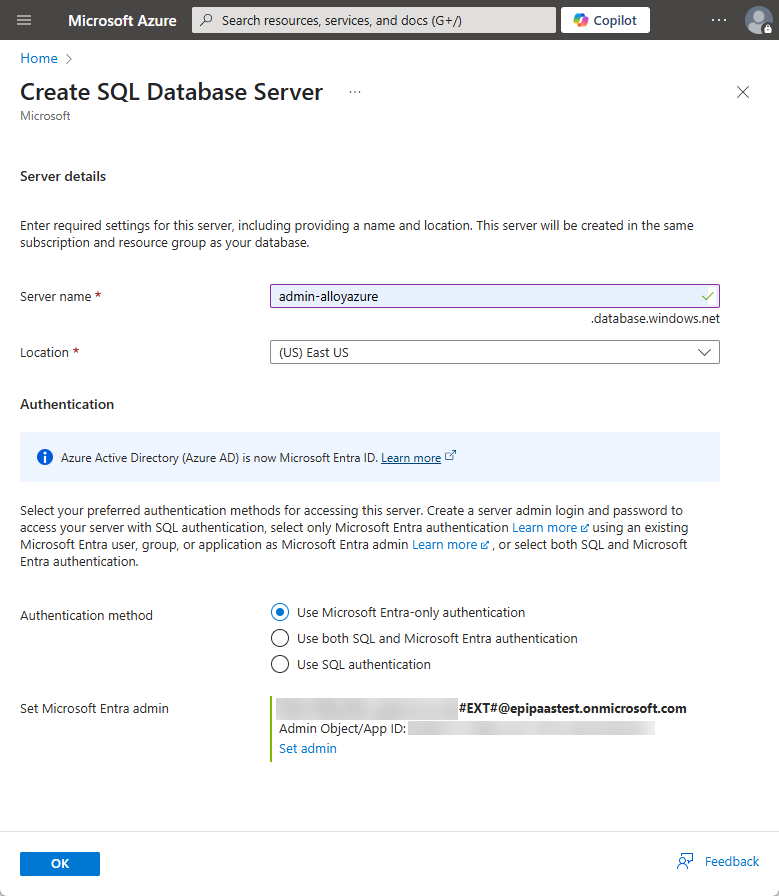
c. Click Review + create and then Create again after you have reviewed your settings.
d. After the database is created, go to the database and select Security > Networking.
e. Open the Public access tab and enable Selected networks.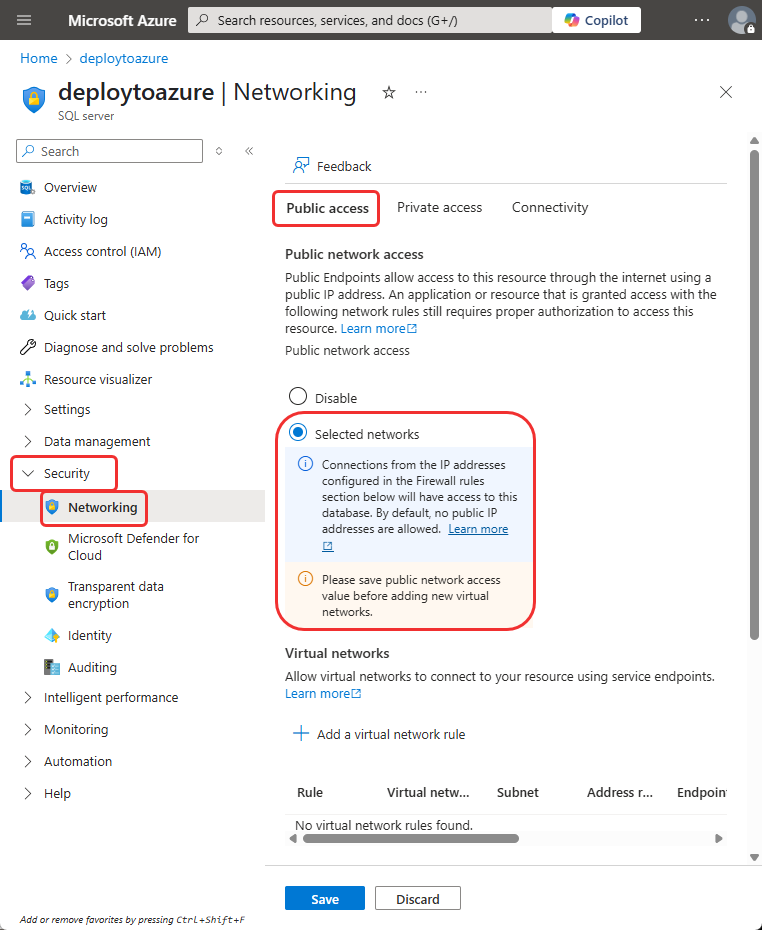
f. Scroll down on the Public access tab and add your client and enable Allow Azure services and resources to access this server.

-
Create Azure BLOB storage.
When you run on Azure, you should store media (such as images) in Azure BLOB storage to enable scaling.
a. Select Create a resource in the top left corner, and select Storage account.**
b. Enter a name for the storage. The storage container name must be in lowercase, such as _mysitemedia_, for DNS compatibility.TipCreate two BLOB storage accounts: one for development and one for production, and switch between them using just the connection string.
c. Adjust other settings as necessary.
d. Click Review + create and then Create again after you have reviewed your settings -
Create a service bus. To scale the site to run on several instances, set up a Service Bus in Azure to handle messages among the site instances.
a. Select Create a resourcein the top left corner, and then Integration > Service Bus.
b. Select a name, a pricing tier, a resource group, and a region.
c. Click Create.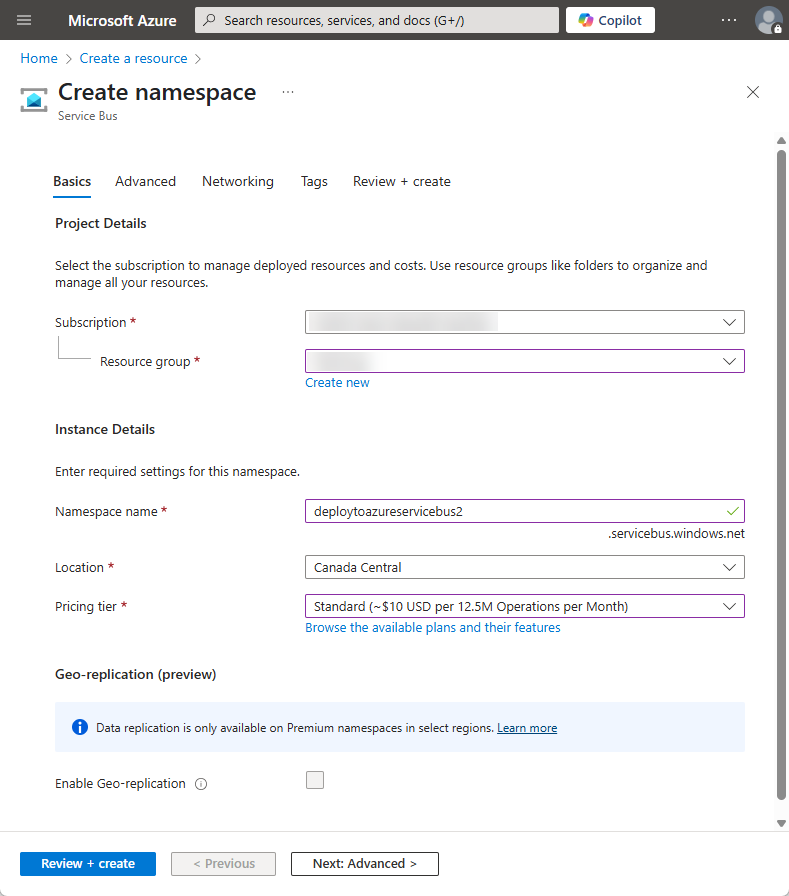
Update the configuration
Change some configurations for the website to work with Azure.
WarningDo not skip this step! If you do, assets are stored locally, and will not deploy properly to the Azure BLOB storage.
There are two ways of configuring Azure resources; one way is by using the EPiServer.Azure package directly and map BLOB and event providers in the appsettings.json, and the other is by using the EPiServer.CloudPlatform.Cms NuGet package. The CloudPlatform configuration applies to DXP deployments using the deployment API.
-
Using the
EPiServer.Azurepackage NuGet directly: Openappsettings.jsonand add the following configuration under theepiserver.frameworksection to map BLOB and event providers to Azure.{ "EPiServer": { "Cms": { "BlobProviders": { "DefaultProvider": "azure", "Providers": { "azure": "EPiServer.Azure.Blobs.AzureBlobProvider, EPiServer.Azure" } }, "AzureBlobProvider": { "ConnectionString": "The contention string", "ContainerName": "The container name" }, "EventProvider": { "Provider": "EPiServer.Azure.Events.AzureEventProvider,EPiServer.Azure" }, "AzureEventProvider": { "ConnectionString": "The contention string", "TopicName": "The topic name " } } } } -
Update connection strings.
In theappsettings.jsonfile, configure the following three connection strings:
a. Change the connection string for EPiServerDB to the SQL database connection string from the Azure portal. Remember to keep the settingMultipleActiveResultSets=true. You can find the connection string to your Azure SQL database in the Azure portal under your SQL database > Overview > Show database connection strings.b. Add a connection string named EPiServerAzureBlobs (it should match the BLOB provider name in
episerver.framework). You can find the connection string to your Azure BLOB provider in the Azure portal under your storage account > Settings > Access keys. The connection string to the BLOB storage should be in the format:connectionString="DefaultEndpointsProtocol=https;AccountName=<name>;AccountKey=<key>"c. Add a connection string named EPiServerAzureEvents (it should match the event provider name in
episerver.framework). You can find the connection string to the event provider in the Azure portal under your service bus account > Settings > Shared access policies. Select the policyRootManagedSharedAccessKey. In a new panel you see the connection strings and access keys. The following example shows the three database connection strings inweb.config, defined for Azure:{ "ConnectionStrings": { "EPiServerDB": "Server=tcp:abcdefgh.database.windows.net,1433;Database=mySiteDB;User ID=dbadmin@abcdefgh;Password={password};Trusted_Connection=False;Encrypt=True;Connection Timeout=30;MultipleActiveResultSets=True", "EPiServerAzureBlobs": "DefaultEndpointsProtocol=https;AccountName=mystorageccount;AccountKey=abcdefghijklmnoabcdefghijklmnoabcdefghijklmno", "EPiServerAzureEvents": "Endpoint=sb://myservicebus.servicebus.windows.net/;SharedAccessKeyName=RootManageSharedAccessKey;SharedAccessKey=abcdefghijklmnoabcdefghijklmnoabcdefghijklmno=" } }
Deploy to Azure
The application or site must be pushed to a container registry, Azure provider, or such resource. There are many ways to push applications to the container registry in Azure; one way is by using Visual Studio, see Microsoft: Container Tools in Visual Studio.
From version 7.7 of CMS, there is a Bootstrap feature for content. It works so that if there is an export package located at [SolutionDir]\App\_Data\DefaultSiteContent.episerverdata that package is imported during initialization, and a site is created. The Bootstrap happens only if the site does not have any previous content. For cloud deployment, you may want to publish the project to the cloud environment before starting a local site configured against the cloud database. In that case, the Bootstrap happens in the cloud environment, which is much faster (because the site and database are likely in the same data center) and also sets the SiteUrl to the cloud URL for the created site.
You can also transfer data to an Optimizely site running on Azure Web Apps using the Optimizely CMS export/import functionality. Export the start page from your local site and database and import on the site running in Azure before continuing to the next step.
Create an admin or edit user
To log in to the site on Azure, create a user with access to the edit or admin view, start the local site while connected to the SQL Database, and perform the following steps. You must let the source IP address access the Azure database server. You can enable this in the Azure Portal on the specific SQL Database server (select the SQL server > Firewall/Virtual Networks > Add client IP). How to create the first user depends on which identity provider is configured; membership or AspNet Identity provider.
Membership Identity Provider
- Start the site (Debug/F5).
- Go to the CMS admin view > Administer Groups.
- Log in with a local Windows administrator account.
- Create the two groups WebAdmins and WebEditors, these are default Optimizely groups providing access to the edit/admin user interface.
- Go to Create User and create a user that is a member of WebAdmins and WebEditors. After deployment, you will need this user later when logging in to the Azure website.
AspNet Identity Provider
- Start the site (Debug/F5).
- You are redirected to a register page to register the first user in the WebAdmins group.
- Go to the CMS admin view > Administer Groups.
- Create another group WebEditors. The WebAdmins and WebEditorsare default Optimizely groups providing access to the edit or admin user interface.
- Go to Create User and create a user that is a member of WebAdmins and WebEditors. After deployment, you will need this user later when logging in to the Azure website.
Activate the license
Go to the CMS admin view and activate your cloud license on test and production environments. The running instances will count towards the total number of instances the license allows. See also Manage cloud licenses.
Change the site URL
Depending on how the site was created (see Deploying content), you might need to update the site definition for the CMS website created in the first steps after deployment. If so, log in to the website and go to the CMS admin view > Settings > Manage Websites, and change the Site URL to the URL in Azure. This will also map a hostname to the correct site in CMS. The URL can be found in the Azure portal. Select your web app > Overview, the site URL is given in the right column.
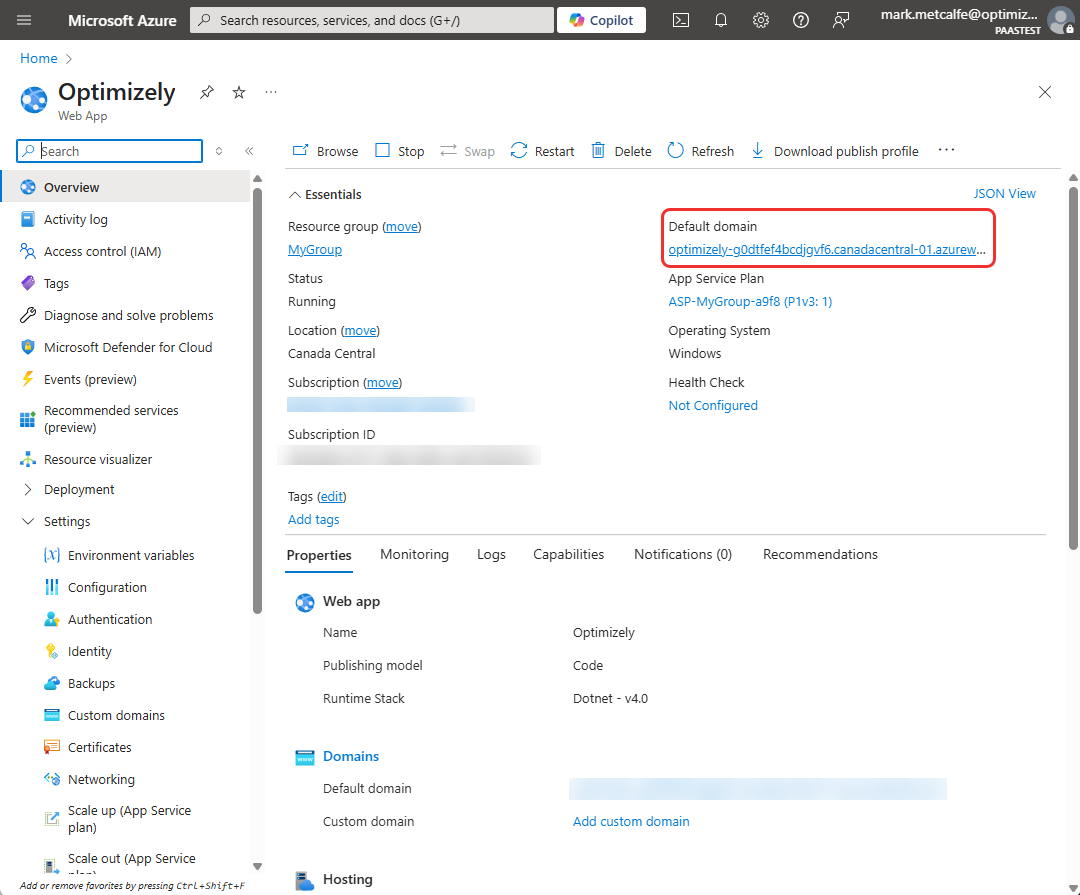
Activate logging
CMS supports writing to the diagnostics log using BLOB storage.
Follow these steps to activate the logging:
- Open your app service and go to Diagnostic settings.
- Click add Add diagnostic setting.
- Select the desired Category, destination, and click Save when done.
NoteThe web app will restart when activating the logging.
SQL database automatic tuning
The Azure SQL Database Automatic tuning is a feature that provides improved performance and automatic tuning of the database, based on AI and machine learning. You should leave the settings as default, and in particular, leave CREATE INDEX as Off, as turning it on might cause problems with the Optimizely Dynamic Data Store (DDS) and sub-optimal indexes.
Search in Azure
You should use a scalable search solution when you host in Azure. It is not recommended to use the Search package in Azure Web Apps, as data corruption can occur in the Lucene index used by the built-in search, when scaling up to multiple instances.
If you need scaling, use Optimizely Search & Navigation instead. This is a hosted service that you connect to, and that works the same way as when your site runs on-premises. Optimizely Search & Navigation is included when running your solution in Optimizely Digital Experience Platform (DXP).
Staged deployment
Azure Web Apps supports deployment slots, so you can deploy new code into a staging environment before moving it to production. To make sure deployment slots do not interfere with the production environment, make sure you define the EPiServerDB, EPiServerAzureEvents, and EPiServerAzureBlobs connection strings in the Azure portal as "sticky" (session affinity) to each slot. If a deployment slot re-uses the production connection strings, it is treated as a load-balanced server, part of the production environment, including licensing restrictions. Search Microsoft documentation for details about using staging with Azure Web Apps.
NoteDefining the
EPiServerDB,EPiServerAzureEvents, andEPiServerAzureBlobsas connection strings in the Azure Portal requires at leastEPiServer.CMS.Core8.3.0.
The core parts of CMS do not use Session State, but some functionality does, such as some audience criteria. There are two approaches to enabling session state, depending on the sticky session feature (also known as session affinity) provided by Azure App Service, which ensures a user is reaching the same server combined with the default in-memory session state provider.
Another approach to enable better scaling is using an optimized provider for Azure, such as the session provider for Azure Web Apps.
Updated about 1 month ago